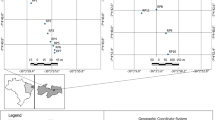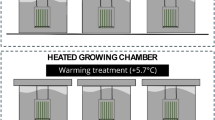Abstract
Weather variations change stream hydrological conditions, affecting the stream function. A seasonal study in three well-conserved first-order Pampean streams was carried out to test the hypothesis that rainfalls are the main drivers of whole-stream metabolism, through their effects on hydrology. We estimated the stream metabolism and metabolic contribution of six relevant communities (angiosperms, macroalgae, seston, epiphyton, epipelon, and hyporheos) during late spring, summer, and winter and examined the relation between gross primary production (GPP) and photosynthetic active radiation (PAR). Our results showed that the decrease in available streambed light due to the dissolved organic carbon after rainfalls was the main factor related to the decrease in the ecosystem and community metabolisms. For instance, GPP oscillated from ~10 gO2 m−2 d−1 in early spring (low flows) to ~3 gO2 m−2 d−1 in summer (high flows). Ecosystem respiration (ER) was less sensitive than GPP to rainfalls due to the increase of hyporheic respiration. Rainfalls also caused a significant loss of downstream macroalgal biomass. At a day scale, the high PAR of late spring and summer saturated GPP during the afternoon, and the low temperature of winter mornings constrained GPP. Hence, the knowledge of weather changes is key to understanding the main hydrological drivers of stream function.





Similar content being viewed by others
References
Acuña, V., A. Giorgi, I. Muñoz, U. Uehlinger & S. Sabater, 2004. Flow extremes and benthic organic matter shape the metabolism of a headwater Mediterranean stream. Freshwater Biology 49: 960–971.
Acuña, V., C. Vilches & A. Giorgi, 2011. As productive and slow as a stream can be – the metabolism of a Pampean stream. Journal of North American Benthological Society 30(1): 71–83.
APHA, 1998. Standard Methods for the Examination of Water and Wastewater. American Public Health Association Inc., Washington DC
Aragón, R., E. G. Jobbágy & E. F. Viglizzo, 2011. Surface and groundwater dynamics in the sedimentary plains of the Western Pampas (Argentina). Ecohydrology 4(3): 433–447.
Bevington, P. R. & D. K. Robinson, 2002. Data Reduction and Error Analysis for the Physical Sciences, 3rd ed. McGraw-Hill, New York.
Borcard, D., P. Legendre & P. Drapeau, 1992. Partialling out the spatial component of ecological variation. Ecology 73: 1045–1055.
Bott, T. L., 2006. Primary productivity and community respiration. In Hauer, F. R. & G. A. Lamberti (eds), Methods in Stream Ecology, 2nd ed. Academic Press, Amsterdam: 663–688.
Bott, T. L., J. T. Brock, C. E. Cushing, S. V. Gregory, D. King & R. C. Petersen, 1978. A comparison of methods for measuring primary productivity and community respiration in streams. Hydrobiologia 60: 3–12.
Chapra, S. C. & D. M. Di Toro, 1991. Delta method for estimating primary production, respiration, and reaeration in streams. Journal of Environmental Engineering 117: 640–655.
De Loe, R., 2008. Floodplain management in Canada: overview and prospects. Canadian Geographer 44(4): 355–368.
Demars, B. O. L., J. R. Manson, J. S. Ólafsson, G. M. Gíslason, R. Gudmundsdóttir, G. Woodward, J. Reiss, D. E. Pichler, J. J. Rasmussen & N. Friberg, 2011. Temperature and the metabolic balance of streams. Freshwater Biology 56: 1106–1121.
Dodds, W. K., J. R. Jones & E. B. Welch, 1998. Suggested classification of stream trophic state: distributions of temperate stream types by chlorophyll, total nitrogen, and phosphorus. Water Research 32: 1455–1462.
Elmore, H. L. & W. F. West, 1961. Effect of water temperature on stream reaeration. Journal of the Sanitary Engineering 87: 59–71.
Elosegui, A. & J. Diez, 2009. La estructura física de los lechos fluviales. In Elosegi, A. & S.Sabater (eds), Conceptos y técnicas en ecología fluvial. Rubes editorial: 70–84.
Feijoó, C. S. & R. J. Lombardo, 2007. Baseline water quality and macrophyte assemblages in Pampean streams: a regional approach. Water Research 41: 1399–1410.
Feijoó, C. S. & M. Menéndez, 2009. La biota de los ríos: los macrófitos. In: Elosegi, A. & S. Sabater (eds), Conceptos y técnicas en ecología fluvial. Rubes editorial: 243–251.
Fellows, C. S., H. M. Valett & C. N. Dahm, 2001. Whole stream metabolism in two montane streams: contribution of the hyporheic zone. Limnology and Oceanography 46: 523–531.
Fisher, S. G., 1983. Succession in streams. In Barnes, J. R. & G. W. Minshall (eds), Stream Ecology: Application and Testing of General Ecological Theory. Plenum Press, New York: 7–27.
Fisher, S. G., L. J. Gray, N. B. Grimm & D. E. Busch, 1982. Temporal succession in a desert stream ecosystem following flash flooding. Ecological Monographs 52: 93–110.
Galat, D. L., L. H. Fredrickson, D. Humburg, K. J. Bataille, J. R. Bodie, J. Dohrenwend, G. Gelwicks, J. E. Havel, D. Helmers, J. B. Hooker, J. R. Jones, M. F. Knowlton, J. Kubisiak, J. Mazourek, A. C. McColpin, R. B. Renken & R. D. Semlitsch, 1998. Flooding to restore connectivity of regulated, large-river wetlands. Bioscience 48(9): 721–733.
Giorgi, A., C. Feijoó & G. Tell, 2005. Primary producers in a Pampean stream: temporal variation and structuring role. Biodiversity Conservation 14: 1699–1718.
Gómez, N., J. C. Donato, A. Giorgi, H. Guasch, P. Mateo & S. Sabater, 2009. La biota de los ríos: los microorganismos autótrofos. In: Elosegi, A., & Sabater, S. (eds), Conceptos y técnicas en ecología fluvial. Rubes editorial: 219–242.
Goodman, L. A., 1960. On the exact variance of products. Journal of the American Statistical Association 55: 708–713.
Gordon, N. D., T. A. McMahon, B. L. Finlayson, C. J. Gippel & R. J. Nathan, 2004. Stream Hydrology. An Introduction for Ecologists, 2nd ed. John Wiley and Sons, Chichester, UK.
Hough, R. A., 1974. Photorespiration and productivity in submersed aquatic vascular plants. Limnology and Oceanography 19: 912–927.
Jackson, T. A. & R. E. Hecky, 1980. Depression of primary productivity by humic matter in lake and reservoir waters of the boreal forest zone. Canadian Journal of Fisheries and Aquatic Sciences 37: 2300–2317.
Jassby, A. D. & T. Platt, 1976. Mathematical formulation of the relationship between photosynthesis and light for phytoplankton. Limnology and Oceanography 21: 540–547.
Johnson, C., B. V. Millett, T. Gilmanov, R. A. Voldseth, G. R. Guntenspergen & D. E. Naugle, 2005. Vulnerability of northern prairie wetlands to climate change. Bioscience 55(10): 863–872.
Mann, C. J. & R. G. Wetzel, 1999. Photosynthesis and stomatal conductance of Juncus effuses in temperate wetland ecosystem. Aquatic Botany 63: 127–144.
Marzolf, E. R., P. J. Mulholland & A. D. Steinman, 1994. Improvements to the diurnal upstream–downstream dissolved oxygen change technique for determining whole-stream metabolism in small streams. Canadian Journal of Fisheries and Aquatic Sciences 51: 1591–1599.
Naegeli, M. W. & U. Uehlinger, 1997. Contribution of the hyporheic zone to ecosystem metabolism in a prealpine gravel-bed river. Journal of the North American Benthological Society 16: 794–804.
Odum, H. T., 1956. Primary production in flowing waters. Limnology and Oceanography 1: 102–117.
Parkhill, K. L. & J. S. Gulliver, 1998. Modeling the effect of light on whole-stream respiration. Ecological Modelling 117: 333–342.
Poff, N. L., J. D. Allan, M. B. Bain, J. R. Karr, K. L. Prestegaard, B. D. Richter, R. E. Sparks & C. Stromberg, 1997. The natural flow regime. A paradigm for river conservation and restoration. BioScience 47(11): 769–784.
SAGPyA & CFA, 1995. El deterioro de las tierras de la República Argentina. Secretaría de Agricultura, Ganadería, Pesca y Alimentos de la Nación y Consejo Federal Agropecuario, Buenos Aires, Argentina.
Scian, B., J. C. Labraga, W. Reimers & O. Frumento, 2006. Characteristics of large-scale atmospheric circulation related to extreme monthly rainfall anomalies in the Pampa Region, Argentina, under non-ENSO conditions. Theoretical and Applied Climatology 85: 89–106.
Shoup, T. E., 1983. Numerical Methods for the Personal Computer. Prentice-Hall, Englewood Cliffs, NJ.
Soriano, A., R. J. C. León, O. E. Sala, R. S. Lavado, V. A. Deregibus, M. A. Cahuépé, O. A. Scaglia, C. A. Velázquez & J. H. Lemcoff, 1992. Río de la Plata grasslands. In Coupland, R. T. (ed), Ecosystems of the World. Natural Grasslands: Introduction and Western Hemisphere. Elsevier, New York: 367–407.
Thyssen, N., M. Erlandsen, E. Jeppesen & C. Ursin, 1987. Reaeration of oxygen in shallow, macrophyte rich streams. 1. Determination of the reaeration rate coefficient. Internationale Revue Der Gesamten Hydrobiologie 72: 405–429.
Uehlinger, U. & M. W. Naegeli, 1998. Ecosystem metabolism, disturbance, and stability in a prealpine gravel bed river. Journal of the North American Benthological Society 17: 165–178.
Uehlinger, U., C. König & P. Reichert, 2000. Variability of photosynthesis-irradiance curves and ecosystem respiration in a small river. Freshwater Biology 44: 493–507.
Velasco, J., A. Millan, M. R. Vidal-Abarca, M. L. Suarez, C. Guerrero & M. Ortega, 2003. Macrophytic, epipelic and epilithic primary production in a semiarid mediterranean stream. Freshwater Biology 48: 1408–1420.
Vilches, C. & A. Giorgi, 2010. Metabolism in a macrophyte-rich stream exposed to flooding. Hydrobiologia 654(1): 57–65.
Wetzel, R. G., 2001. Limnology: Lake and River Ecosystems. Academic Press, London, UK.
Wetzel, R. G. & G. E. Likens, 1991. Limnological Analyses, 2nd ed. Springer, New York.
Zhang, Y. L., B. Q. Qin, W. M. Chen & G. W. Zhu, 2005. A preliminary study of chromophoric dissolved organic matter (CDOM) in lake Taihu, a shallow subtropical lake in China. Acta Hydrochimica et Hydrobiologica 33(4): 315–323.
Acknowledgments
The authors acknowledge Amarú Olivia Leggieri. We wish to thank Julieta De Anna, Martín Da Silva, Eduardo Zunino, Carolina Rodríguez Castro, Ricardo Leggieri, and Carolina Vilches for field assistance and Dr Julie Sanford, Dr. C. Coviella, and M. V. Gonzalez Eusevi for improving the English text. The manuscript has benefited greatly from the comments of Dr L. M. Bini and the two anonymous reviewers. The study was supported by the FONCyT (Ministerio de Ciencia, Tecnología e Innovación Productiva), the National University of Luján (Buenos Aires, Argentina), and the BBVA Fundation. L. Leggieri is a PRH (ANCYPT-UNLu) doctorate fellow.
Author information
Authors and Affiliations
Corresponding author
Additional information
Handling editor: Luis Mauricio Bini
Electronic supplementary material
Below is the link to the electronic supplementary material.
Rights and permissions
About this article
Cite this article
Leggieri, L., Feijoó, C., Giorgi, A. et al. Seasonal weather effects on hydrology drive the metabolism of non-forest lowland streams. Hydrobiologia 716, 47–58 (2013). https://doi.org/10.1007/s10750-013-1543-4
Received:
Revised:
Accepted:
Published:
Issue Date:
DOI: https://doi.org/10.1007/s10750-013-1543-4




